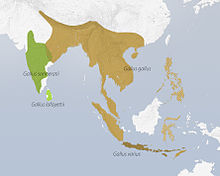Junglefowl

Multi tool use
| Junglefowl Temporal range: Late Miocene–recent PreЄ Є O S D C P T J K Pg N | |
|---|---|
 | |
Grey junglefowl (G. sonneratii) hen | |
Scientific classification | |
| Kingdom: | Animalia |
| Phylum: | Chordata |
| Class: | Aves |
| Order: | Galliformes |
| Subfamily: | Phasianinae |
| Genus: | Gallus Brisson, 1760 |
Type species | |
Phasianus gallus Linnaeus, 1758 | |
| Species | |
| |
 | |
Gallus gallus Gallus lafayettii Gallus sonneratii Gallus varius | |
Junglefowl are the four living species of bird from the genus Gallus in the bird order Galliformes, which occur in India, Sri Lanka, and Southeast Asia.
These are large birds, with colourful male plumage, but are nevertheless difficult to see in the dense vegetation they inhabit.
As with many birds in the pheasant family, the male takes no part in the incubation of the egg or rearing of the precocial young. These duties are performed by the drab and well-camouflaged female.
The junglefowl are seed-eaters, but insects are also taken, particularly by the young birds.
One of the species in this genus, the red junglefowl, is of historical importance as the likely ancestor of the domesticated chicken, although the grey junglefowl has been suggested to be also involved.[1]
The Sri Lankan junglefowl is the national bird of Sri Lanka.
Contents
1 Taxonomy
1.1 Extant species
2 Fossils
3 References
Taxonomy
The genus Gallus was erected by the French scientist Mathurin Jacques Brisson in his Ornithologie published in 1760.[2] The type species is the red junglefowl (Gallus gallus).[3] The Swedish naturalist Carl Linnaeus had introduced the genus Gallus in the 6th edition of his Systema Naturae published in 1748,[4] but Linnaeus dropped the genus in the important tenth edition of 1758 and put the red junglefowl together with the common pheasant in the genus Phasianus.[5][6] As the publication date of Linnaeus's sixth edition was before the 1758 starting point of the International Commission on Zoological Nomenclature, Brisson and not Linnaeus is considered as the authority for the genus.[7]
Extant species
The genus contains four species:[8]
| Image | Scientific name | Common Name | Distribution |
|---|---|---|---|
 |
Gallus gallus | Red junglefowl or chicken |
Tamil Nadu, India, eastwards across Indochina and southern China and into Malaysia, Singapore, Philippines and Indonesia |
 |
Gallus lafayettii | Sri Lankan junglefowl | Sri Lanka |
 |
Gallus sonneratii | Grey junglefowl | Indian Peninsula, but extends into Gujarat, Madhya Pradesh, and south Rajasthan |
 |
Gallus varius | Green junglefowl | Java, Bali, Lombok, Komodo, Flores, Rinca, and small islands linking Java with Flores, Indonesia |
Fossils
Prehistorically, the genus Gallus was found all over Eurasia; in fact, it appears to have evolved in southeastern Europe. Several fossil species have been described, but their distinctness is not firmly established in all cases:
Gallus aesculapii (Late Miocene/Early Pliocene of Greece) - possibly belongs into Pavo
Gallus moldovicus (Late Pliocene of Moldavia) - sometimes misspelt moldavicus, may be synonym of Pavo bravardi
Gallus beremendensis (Late Pliocene/Early Pleistocene of Eastern Europe)- Giant junglefowl Gallus karabachensis (Early Pleistocene of Nagorno-Karabakh)
Gallus tamanensis (Early Pleistocene? of Taman Peninsula)
Gallus kudarensis (Early/Middle Pleistocene of Kudaro, South Ossetia)
Gallus europaeus (Middle Pleistocene of Italy)
Gallus sp. (Middle/Late Pleistocene of Trinka Cave, Moldavia)
Gallus imereticus (Late Pleistocene of Gvardjilas-Klde, Imeretia)
Gallus meschtscheriensis (Late Pleistocene of Soungir, Russia)
Gallus georgicus (Late Pleistocene - Early Holocene of Georgia)
Gallus sp. (Late Pleistocene of Krivtcha Cave, Ukraine)
Gallus sp. (Early Holocene of Dnieper region)
| Wikimedia Commons has media related to Gallus. |
References
^ Eriksson, J.; et al. (2008). "Identification of the yellow skin gene reveals a hybrid origin of the domestic chicken". PLoS Genetics. 4 (2). e1000010. doi:10.1371/journal.pgen.1000010..mw-parser-output cite.citation{font-style:inherit}.mw-parser-output q{quotes:"""""""'""'"}.mw-parser-output code.cs1-code{color:inherit;background:inherit;border:inherit;padding:inherit}.mw-parser-output .cs1-lock-free a{background:url("//upload.wikimedia.org/wikipedia/commons/thumb/6/65/Lock-green.svg/9px-Lock-green.svg.png")no-repeat;background-position:right .1em center}.mw-parser-output .cs1-lock-limited a,.mw-parser-output .cs1-lock-registration a{background:url("//upload.wikimedia.org/wikipedia/commons/thumb/d/d6/Lock-gray-alt-2.svg/9px-Lock-gray-alt-2.svg.png")no-repeat;background-position:right .1em center}.mw-parser-output .cs1-lock-subscription a{background:url("//upload.wikimedia.org/wikipedia/commons/thumb/a/aa/Lock-red-alt-2.svg/9px-Lock-red-alt-2.svg.png")no-repeat;background-position:right .1em center}.mw-parser-output .cs1-subscription,.mw-parser-output .cs1-registration{color:#555}.mw-parser-output .cs1-subscription span,.mw-parser-output .cs1-registration span{border-bottom:1px dotted;cursor:help}.mw-parser-output .cs1-hidden-error{display:none;font-size:100%}.mw-parser-output .cs1-visible-error{font-size:100%}.mw-parser-output .cs1-subscription,.mw-parser-output .cs1-registration,.mw-parser-output .cs1-format{font-size:95%}.mw-parser-output .cs1-kern-left,.mw-parser-output .cs1-kern-wl-left{padding-left:0.2em}.mw-parser-output .cs1-kern-right,.mw-parser-output .cs1-kern-wl-right{padding-right:0.2em}
^ Brisson, Mathurin Jacques (1760). Ornithologie, ou, Méthode contenant la division des oiseaux en ordres, sections, genres, especes & leurs variétés (in French and Latin). Volume 1. Paris: Jean-Baptiste Bauche. Vol. 1, p. 26, Vol. 1, p. 166.
^ Peters, James Lee, ed. (1934). Check-list of Birds of the World. Volume 2. Cambridge, Massachusetts: Harvard University Press. p. 118.
^ Linnaeus, Carl (1748). Systema Naturae sistens regna tria naturae, in classes et ordines, genera et species redacta tabulisque aeneis illustrata (in Latin) (6th ed.). Stockholmiae (Stockholm): Godofr, Kiesewetteri. pp. 16, 28.
^ Linnaeus, Carl (1758). Systema Naturæ per regna tria naturae, secundum classes, ordines, genera, species, cum characteribus, differentiis, synonymis, locis (in Latin). Volume 1 (10th ed.). Holmiae (Stockholm): Laurentii Salvii. p. 158.
^ Allen, J.A. (1910). "Collation of Brisson's genera of birds with those of Linnaeus". Bulletin of the American Museum of Natural History. 28: 317–335.
^ "Article 3". International Code of Zoological Nomenclature (4th ed.). London: International Trust for Zoological Nomenclature. 1999. ISBN 978-0-85301-006-7.
^ Gill, Frank; Donsker, David, eds. (2017). "Pheasants, partridges & francolins". World Bird List Version 7.3. International Ornithologists' Union. Retrieved 22 November 2017.
Steve Madge; Philip J. K. McGowan; Guy M. Kirwan (2002). Pheasants, Partidges and Grouse: A Guide to the Pheasants, Partridges, Quails, Grouse, Guineafowl, Buttonquails and Sandgrouse of the World. A&C Black. ISBN 978-0-7136-3966-7.
Hvh5 PtUz 2ote0ifJq,OJVCqEii8 zSFSreRUCJU